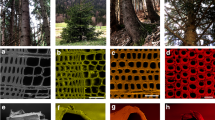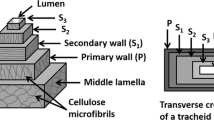Abstract
This paper, which describes work from an extensive study of various plant species, is aimed at presenting the best common physical description of the mechanism of failure in tension of cellulose-based fibres. A correlation coefficient of r=0.69 was observed between the mean tensile strengths and Young's moduli of fibres extracted from leaves, stems, and other miscellaneous sources. This observation is attributed to increases in Young's modulus and tensile strength with decreasing microfibril angle and increasing cellulose content. A cylindrical cell model was applied to the mean tensile strengths of fibres preconditioned at 24 to 27° C and 60% relative humidity. A modification of the resulting expression was used to produce the best correlation coefficient of r=0.89 between predicted and measured mean tensile strengths. However, the importance of cellulose content for strength which is presently illustrated for various plant species is not reflected in terms of mean fracture strain, which was increased by increasing microfibril angle showing why high works of fracture can be obtained from different species.
Similar content being viewed by others
References
G. Jeronimides, Leiden Botanical Series No. 3 (1976) p. 253.
E. C. Mclaughlin and R. A. Tait, J. Mater. Sci. 14 (1979) 998.
L. J. Rebenfeld, J. Pot. Sci. C. 9 (1965) 91.
D. H. Page, F. El-Hosseiny, K. Winkler and R. Bain, Canadian Pulp and Paper Association — Meetings of the Technical Section, August (1972) T198.
L. R. G. Treloar, Physics Today, December (1977) 23.
A. Frey-Wyssling, “The Plant Cell Wall” (Gebrüder Bornbraegar, Berlin, 1976) p. 217.
J. Grant, “A Laboratory Handbook of Pulp and Paper Manufacture”, 2nd Edn (Edward Arnold, London, 1961) p. 131.
R. D. Preston, “The Molecular Architecture of Plant Cell Walls” (Chapman and Hall, London, 1952) pp. 40, 120.
L. Holliday, “Composite Materials”, (Elsevier, Amsterdam, 1966) p. 486.
R. E. Mark, “Cell Wall Mechanics of Tracheids” (Yale University Press, New Haven, 1967) p. 107.
R. D. Preston, “The Physical Biology of Plant Cell Walls” (Chapman and Hall, London, 1974) p. 376.
R. E. Mark, “Cell Wall Mechanics of Tracheids” (Yale University Press, New Haven, 1967) p. 144.
P. S. Srinivasan, Quart. J. Indian Inst. Sci. 4 (2) (1941) 222.
L. R. G. Treloar, Polymer 1 (1960) 290.
M. A. Jawson, P. P. Gillis and R. E. Mark, Proc. Roy. Soc. A 306 (1968) 389.
Author information
Authors and Affiliations
Rights and permissions
About this article
Cite this article
McLaughlin, E.C., Tait, R.A. Fracture mechanism of plant fibres. J Mater Sci 15, 89–95 (1980). https://doi.org/10.1007/BF00552431
Received:
Accepted:
Issue Date:
DOI: https://doi.org/10.1007/BF00552431




